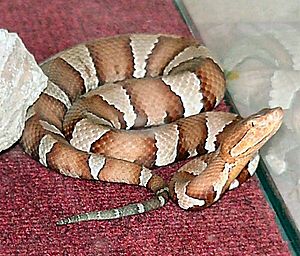Agkistrodon contortrix pictigaster facts for kids
Quick facts for kids Agkistrodon contortrix pictigaster |
|
|---|---|
 |
|
| Scientific classification |
|
| Kingdom: | Animalia |
| Phylum: | Chordata |
| Class: | Reptilia |
| Order: | Squamata |
| Suborder: | Serpentes |
| Family: | Viperidae |
| Genus: | Agkistrodon |
| Species: | |
| Subspecies: |
A. c. pictigaster
|
| Trinomial name | |
| Agkistrodon contortrix pictigaster Gloyd & Conant, 1943
|
|
| Synonyms | |
|
|
Common names: Trans-Pecos copperhead, western copperhead
The Trans-Pecos copperhead (scientific name: Agkistrodon contortrix pictigaster) is a type of venomous snake. It is a subspecies of pit viper found in the Trans-Pecos area. This region is in western Texas in the United States and also in northeastern Mexico.
What Does It Look Like?
This snake usually has a light tan color. It has wide bands of darker brown across its body. Its exact color can change depending on where it lives. It might be reddish-brown or grayish-brown.
It can be tricky to tell this snake apart from the broad-banded copperhead. That snake's scientific name is A. c. laticinctus. The main difference is the belly pattern. The Trans-Pecos copperhead often has a detailed pattern of white and black on its underside. The broad-banded copperhead usually has a plain white belly.
Other types of copperheads have bands that get narrower near their spine. This makes the bands look like hourglass shapes. But the Trans-Pecos copperhead has bands that stay wide all the way across. They do not narrow at the spine. These snakes usually grow to be about 20 to 36 inches (50 to 90 cm) long.
When they are young, all types of Agkistrodon snakes have a bright green-yellow tail tip. Scientists think they use this bright tail to trick prey. It might look like a worm, attracting small animals close enough to strike. This bright color fades to gray or brown when the snake is about one year old.
How Does It Behave?
Like other copperheads, the Trans-Pecos copperhead is a nocturnal hunter. This means it is active mostly at night. It is an ambush predator. This means it waits for its prey to come close before striking.
Its diet mainly includes lizards, frogs, and rodents. Among all copperhead types, this one prefers the driest places. It likes rocky areas with light plant growth, often in canyons.
These snakes are ovoviviparous. This means they give birth to live young, but the eggs hatch inside the mother's body. They usually have a litter of up to 8 young snakes. This happens in the early fall.
About Its Venom
Like most pit vipers, the Trans-Pecos copperhead has hemotoxic venom. This type of venom affects blood and tissues. The snake delivers its venom through hollow fangs. These fangs are hinged, meaning they can fold back when not in use. When the snake strikes, the fangs swing forward. They work like hypodermic needles, injecting the venom quickly.
A bite from a copperhead is usually not life-threatening for a healthy adult. However, it can cause swelling, tissue damage (called necrosis), and a lot of pain in the bitten area. Any bite from a venomous snake should be taken seriously. You should always get medical help right away.
There is no specific antivenom made just for copperheads. But a medicine called CroFab can be used for serious bites. CroFab is made using venom from the cottonmouth snake (Agkistrodon piscivorus).
See Also
- Agkistrodon contortrix at the TIGR Reptile Database. Accessed 7 December 2007.

